Numerical and Experimental Investigations of the Interactions between Hydraulic and Natural Fractures in Shale Formations
Abstract
1. Introduction
2. Methods
2.1. Displacement Discontinuity Method
2.2. Fracture Initiation and Propagation
2.3. Mohr-Coulomb Joint Element
2.4. Numerical Procedure
3. Model Verifications
4. Case Studies
4.1. Displacements and Stresses along the Natural Fracture (NF)
4.2. Parametric Study of Stress Distribution and Unstable Tensile Zone along the NF
4.3. Effects of Natural Fracture on the Hydraulic Fracture (HF) Propagation Path
5. Experimental Investigation
5.1. Experimental Setup and Sample Preparation
5.2. Experimental Results and Analyses
6. Conclusions
- (1)
- The hydraulic fracture morphology of shale was strongly influenced by the characteristics of its natural fractures. The NF density, orientation, and cemented strength, are three main factors dominating the formation of complex fracture networks.
- (2)
- The cemented strength of the NF caused a noticeable nonlinear behavior for this problem. For an NF with a low strength, only shear failure occurred, and the HF was more likely to terminate. However, for an NF with a moderate strength, the hybrid failure model (tensile failure and shear failure co-existence, and conversion) may occur, and the HF is more inclined to step over at the contact.
- (3)
- The displacements and stresses along the NF all changed in a highly dynamic manner. During the stage of approach of the HF to an NF, the HF tip could exert a remote compressional and shear stress on the NF interface, which could lead to the debonding of the natural fracture. Meanwhile, a maximum principal stress peak is generated at the end of the opening zone, where a new tensile crack is more likely to occur.
- (4)
- The location and value of the stress is the function of NF inclination angle, far-field differential stress as well as HF net pressure. For small approaching angles, the stress peak is located farther from the intersection point, so a step over (offset) fracture is more likely to occur. The same effect can be found by a higher HF net pressure, because the stress perturbation ahead the NF is proportional to the fluid pressure in the HF.
- (5)
- Meanwhile, the HF was found to be more prone to deviate from its original propagation path and reoriented near the NF because the deformation of the NF.
Author Contributions
Funding
Conflicts of Interest
Appendix A
Appendix B

Nomenclature
| length of the tip element (L) | |
| empricial correction coefficient in Equation (4) | |
| shear displacement discontinuity of the j-th element (L) | |
| normal displacement discontinuity of the j-th element (L) | |
| normalized displacement discontinuities | |
| modulus of elasticity (ML−1T−2) | |
| stress intensity factor of kind I (ML−1/2T−2) | |
| stress intensity factor of kind II (ML−1/2T−2) | |
| fracture toughness (ML−1/2T−2) | |
| shear stress stiffness (ML−2T−2) | |
| normal stress stiffness (ML−2T−2) | |
| shear displacements of the i-th element (L) | |
| normal displacements of the i-th element (L) | |
| Poisson’s ratio | |
| dimensionless coordinate in the x direction | |
| dimensionless coordinate in the y direction | |
| average of the horizontal stresses (ML−1T−2) | |
| difference of the horizontal stresses (ML−1T−2) | |
| shear components of stress at the midpoint of the i-th element (ML−1T−2) | |
| normal components of stress at the midpoint of the i-th element (ML−1T−2) | |
| initial shear stress (ML−1T−2) | |
| initial normal stress (ML−1T−2) | |
| yield shear stress (ML−1T−2) | |
| fracture initiation angle | |
| normalized gap between the two fractures | |
| normalized net pressure | |
| normalized horizontal stress difference |
References
- KERR, R.A. Natural Gas From Shale Bursts Onto the Scene. Science 2010, 328, 1624–1626. [Google Scholar] [CrossRef] [PubMed]
- US Energy Information Administration. Annual Energy Outlook 2013; US Energy Information Administration: Washington, DC, USA, 2013; pp. 60–62. [Google Scholar]
- US Energy Information Administration. Annual Energy Outlook 2011: With Projections to 2035; Government Printing Office: Washington, DC, USA, 2011.
- Shen, W.; Li, X.; Xu, Y.; Sun, Y.; Huang, W. Gas flow behavior of nanoscale pores in shale gas reservoirs. Energies 2017, 10, 751. [Google Scholar] [CrossRef]
- Gale, J.F.; Reed, R.M.; Holder, J. Natural fractures in the Barnett Shale and their importance for hydraulic fracture treatments. AAPG Bull. 2007, 91, 603–622. [Google Scholar] [CrossRef]
- Daniels, J.L.; Waters, G.A.; Le Calvez, J.H.; Bentley, D.; Lassek, J.T. Contacting more of the Barnett Shale through an Integration of Real-Time Microseismic Monitoring, Petrophysics, and Hydraulic Fracture Design. In Proceedings of the SPE Annual Technical Conference and Exhibition, Anaheim, CA, USA, 11–14 November 2007. [Google Scholar]
- Fisher, M.K.; Wright, C.; Davidson, B.; Goodwin, A.; Fielder, E.; Buckler, W.; Steinsberger, N. Integrating Fracture Mapping Technologies to Optimize Stimulations in the Barnett Shale. In Proceedings of the SPE Annual Technical Conference and Exhibition, San Antonio, TX, USA, 29 September–2 October 2002. [Google Scholar]
- Maxwell, S.C.; Urbancic, T.; Steinsberger, N.; Zinno, R. Microseismic imaging of hydraulic fracture complexity in the Barnett shale. In Proceedings of the SPE Annual Technical Conference and Exhibition, San Antonio, TX, USA, 29 September–2 October 2002. [Google Scholar]
- Lamont, N.; Jessen, F. The effects of existing fractures in rocks on the extension of hydraulic fractures. J. Pet. Technol. 1963, 15, 203–209. [Google Scholar] [CrossRef]
- Daneshy, A.A. Hydraulic fracture propagation in the presence of planes of weakness. In Proceedings of the SPE European Spring Meeting, Amsterdam, The Netherlands, 29–30 May 1974. [Google Scholar]
- Anderson, G.D. Effects of friction on hydraulic fracture growth near unbonded interfaces in rocks. Soc. Pet. Eng. J. 1981, 21, 21–29. [Google Scholar] [CrossRef]
- Blanton, T.L. An experimental study of interaction between hydraulically induced and pre-existing fractures. In Proceedings of the SPE Unconventional Gas Recovery Symposium, Pittsburgh, PA, USA, 16–18 May 1982. [Google Scholar]
- Warpinski, N.; Teufel, L. Influence of geologic discontinuities on hydraulic fracture propagation (includes associated papers 17011 and 17074). J. Pet. Technol. 1987, 39, 209–220. [Google Scholar] [CrossRef]
- Beugelsdijk, L.; De Pater, C.; Sato, K. Experimental hydraulic fracture propagation in a multi-fractured medium. In Proceedings of the SPE Asia Pacific Conference on Integrated Modelling for Asset Management, Yokohama, Japan, 25–26 April 2000. [Google Scholar]
- Zhou, J.; Chen, M.; Jin, Y.; Zhang, G.Q. Analysis of fracture propagation behavior and fracture geometry using a tri-axial fracturing system in naturally fractured reservoirs. Int. J. Rock Mech. Min. Sci. 2008, 45, 1143–1152. [Google Scholar] [CrossRef]
- Olson, J.E.; Bahorich, B.; Holder, J. Examining hydraulic fracture: Natural fracture interaction in hydrostone block experiments. In Proceedings of the SPE Hydraulic Fracturing Technology Conference, The Woodlands, TX, USA, 6–8 February 2012. [Google Scholar]
- Lee, H.P.; Olson, J.E.; Holder, J.; Gale, J.F.; Myers, R.D. The interaction of propagating opening mode fractures with preexisting discontinuities in shale. J. Geophys. Res. Solid Earth 2015, 120, 169–181. [Google Scholar] [CrossRef]
- Alabbad, E.A.; Olson, J.E. Examining the Geomechanical Implicaitons of Pre-Existing Fractures and Simultaneous-Multi-Fracturing Completions on Hydraulic Fractures: Experimental Insights into Fracturing Unconventional Formations. In Proceedings of the SPE Annual Technical Conference and Exhibition, Dubai, UAE, 26–28 September 2016. [Google Scholar]
- Blanton, T.L. Propagation of hydraulically and dynamically induced fractures in naturally fractured reservoirs. In Proceedings of the SPE Unconventional Gas Technology Symposium, Louisville, Kentucky, 8–21 May 1986. [Google Scholar]
- Cheng, W.; Yan, J.; Mian, C.; Tong, X.; Zhang, Y.; Ce, D. A criterion for identifying hydraulic fractures crossing natural fractures in 3D space. Petr. Explor. Dev. 2014, 41, 371–376. [Google Scholar] [CrossRef]
- Chuprakov, D.; Melchaeva, O.; Prioul, R. Hydraulic fracture propagation across a weak discontinuity controlled by fluid injection. In Proceedings of the Effective and Sustainable Hydraulic Fracturing, Brisbane, Australia, 20–22 May 2013. [Google Scholar]
- Gu, H.; Weng, X. Criterion for fractures crossing frictional interfaces at non-orthogonal angles. In 44th US Rock Mechanics Symposium and 5th US-Canada Rock Mechanics Symposium; American Rock Mechanics Association: Salt Lake City, UT, USA, 2010. [Google Scholar]
- Gu, H.; Weng, X.; Lund, J.B.; Mack, M.G.; Ganguly, U.; Suarez-Rivera, R. Hydraulic fracture crossing natural fracture at nonorthogonal angles: A criterion and its validation. SPE Prod. Oper. 2012, 27, 20–26. [Google Scholar] [CrossRef]
- Potluri, N.; Zhu, D.; Hill, A.D. The effect of natural fractures on hydraulic fracture propagation. In Proceedings of the SPE European Formation Damage Conference, Sheveningen, The Netherlands, 25–27 May 2005. [Google Scholar]
- Renshaw, C.; Pollard, D. An experimentally verified criterion for propagation across unbounded frictional interfaces in brittle, linear elastic materials. In International Journal of Rock Mechanics and Mining Sciences Geomechanics Abstracts; Elsevier: New York, NY, USA, 1995; pp. 237–249. [Google Scholar]
- Sarmadivaleh, M.; Rasouli, V. Modified Reinshaw and Pollard criteria for a non-orthogonal cohesive natural interface intersected by an induced fracture. Rock Mech. Rock Eng. 2014, 47, 2107–2115. [Google Scholar] [CrossRef]
- Yao, Y.; Wang, W.; Keer, L.M. An energy based analytical method to predict the influence of natural fractures on hydraulic fracture propagation. Eng. Fract. Mech. 2018, 189, 232–245. [Google Scholar] [CrossRef]
- Bao, J.; Fathi, E.; Ameri, S. A coupled finite element method for the numerical simulation of hydraulic fracturing with a condensation technique. Eng. Fract. Mech. 2014, 131, 269–281. [Google Scholar] [CrossRef]
- Fu, P.; Johnson, S.M.; Carrigan, C.R. An explicitly coupled hydro-geomechanical model for simulating hydraulic fracturing in arbitrary discrete fracture networks. Int. J. Numer. Anal. Methods Geomech. 2013, 37, 2278–2300. [Google Scholar] [CrossRef]
- Nassir, M.; Settari, A.; Wan, R.G. Modeling shear dominated hydraulic fracturing as a coupled fluid-solid interaction. In Proceedings of the International Oil and Gas Conference and Exhibition in China, Beijing, China, 8–10 June 2010. [Google Scholar]
- Nikam, A.; Awoleke, O.O.; Ahmadi, M. Modeling the Interaction Between Natural and Hydraulic Fractures Using Three Dimensional Finite Element Analysis. In Proceedings of the SPE Western Regional Meeting, Anchorage, AK, USA, 23–26 May 2016. [Google Scholar]
- Rahman, M.; Rahman, S. Studies of hydraulic fracture-propagation behavior in presence of natural fractures: Fully coupled fractured-reservoir modeling in poroelastic environments. Int. J. Geomech. 2013, 13, 809–826. [Google Scholar] [CrossRef]
- Rahman, M.M.; Aghighi, M.A.; Rahman, S.S.; Ravoof, S.A. Interaction between induced hydraulic fracture and pre-existing natural fracture in a poro-elastic environment: Effect of pore pressure change and the orientation of natural fractures. In Proceedings of the Asia Pacific Oil and Gas Conference & Exhibition, Jakarta, Indonesia, 4–6 August 2009. [Google Scholar]
- Bryant, E.C.; Hwang, J.; Sharma, M.M. Arbitrary fracture propagation in heterogeneous poroelastic formations using a finite volume-based cohesive zone model. In Proceedings of the SPE Hydraulic Fracturing Technology Conference, The Woodlands, TX, USA, 3–5 February 2015. [Google Scholar]
- Chen, Z.; Bunger, A.; Zhang, X.; Jeffrey, R.G. Cohesive zone finite element-based modeling of hydraulic fractures. Acta Mech. Solida Sin. 2009, 22, 443–452. [Google Scholar] [CrossRef]
- Chen, Z.; Jeffrey, R.G.; Zhang, X.; Kear, J. Finite-element simulation of a hydraulic fracture interacting with a natural fracture. SPE J. 2017, 22, 219–234. [Google Scholar] [CrossRef]
- Dean, R.H.; Schmidt, J.H. Hydraulic-fracture predictions with a fully coupled geomechanical reservoir simulator. Spe J. 2009, 14, 707–714. [Google Scholar] [CrossRef]
- Guo, J.; Zhao, X.; Zhu, H.; Zhang, X.; Pan, R. Numerical simulation of interaction of hydraulic fracture and natural fracture based on the cohesive zone finite element method. J. Nat. Gas Sci. Eng. 2015, 25, 180–188. [Google Scholar]
- Sarris, E.; Papanastasiou, P. Modeling of hydraulic fracturing in a poroelastic cohesive formation. Int. J. Geomech. 2011, 12, 160–167. [Google Scholar] [CrossRef]
- Wang, H. Numerical modeling of non-planar hydraulic fracture propagation in brittle and ductile rocks using XFEM with cohesive zone method. J. Petr. Sci. Eng. 2015, 135, 127–140. [Google Scholar] [CrossRef]
- Yao, Y.; Liu, L.; Keer, L.M. Pore pressure cohesive zone modeling of hydraulic fracture in quasi-brittle rocks. Mech. Mater. 2015, 83, 17–29. [Google Scholar] [CrossRef]
- Behnia, M.; Goshtasbi, K.; Marji, M.F.; Golshani, A. Numerical simulation of interaction between hydraulic and natural fractures in discontinuous media. Acta Geotech. 2015, 10, 533–546. [Google Scholar] [CrossRef]
- Cooke, M.L.; Underwood, C.A. Fracture termination and step-over at bedding interfaces due to frictional slip and interface opening. J. Struct. Geol. 2001, 23, 223–238. [Google Scholar] [CrossRef]
- De Pater, C.; Beugelsdijk, L. Experiments and numerical simulation of hydraulic fracturing in naturally fractured rock. In Proceedings of the Alaska Rocks 2005, The 40th US Symposium on Rock Mechanics (USRMS), Anchorage, AK, USA, 25–29 June 2005. [Google Scholar]
- Kresse, O.; Weng, X.; Gu, H.; Wu, R. Numerical modeling of hydraulic fractures interaction in complex naturally fractured formations. Rock Mech. Rock Eng. 2013, 46, 555–568. [Google Scholar] [CrossRef]
- Marji, M.F. Numerical analysis of quasi-static crack branching in brittle solids by a modified displacement discontinuity method. Int. J. Solids Struct. 2014, 51, 1716–1736. [Google Scholar] [CrossRef]
- McClure, M.; Babazadeh, M.; Shiozawa, S.; Huang, J. Fully coupled hydromechanical simulation of hydraulic fracturing in three-dimensional discrete fracture networks. In Proceedings of the SPE Hydraulic Fracturing Technology Conference, The Woodlands, TX, USA, 3–5 February 2015. [Google Scholar]
- Weng, X. Modeling of complex hydraulic fractures in naturally fractured formation. J. Unconv. Oil Gas Resour. 2015, 9, 114–135. [Google Scholar] [CrossRef]
- Wu, K.; Olson, J.E. A simplified three-dimensional displacement discontinuity method for multiple fracture simulations. Int. J. Fract. 2015, 193, 191–204. [Google Scholar] [CrossRef]
- Wu, K.; Olson, J.E. Numerical investigation of complex hydraulic-fracture development in naturally fractured reservoirs. SPE Prod. Oper. 2016, 31, 300–309. [Google Scholar]
- Xie, L.; Min, K.-B.; Shen, B. Simulation of hydraulic fracturing and its interactions with a pre-existing fracture using displacement discontinuity method. J. Nat. Gas Sci. Eng. 2016, 36, 1284–1294. [Google Scholar] [CrossRef]
- Xue, W. Numerical Investigation of Interaction between Hydraulic Fractures and Natural Fractures. Ph.D. Thesis, Texas A & M University, College Station, TX, USA, December 2011. [Google Scholar]
- Zhang, X.; Jeffrey, R.; Bunger, A.; Thiercelin, M. Initiation and growth of a hydraulic fracture from a circular wellbore. Int. J. Rock Mech. Min. Sci. 2011, 48, 984–995. [Google Scholar] [CrossRef]
- Zhang, X.; Jeffrey, R.G. Reinitiation or termination of fluid-driven fractures at frictional bedding interfaces. J. Geophys. Res. Solid Earth 2008, 113. [Google Scholar] [CrossRef]
- Zhang, Z.; Li, X. Numerical study on the formation of shear fracture network. Energies 2016, 9, 299. [Google Scholar] [CrossRef]
- Zangeneh, N.; Eberhardt, E.; Bustin, R. Investigation of the influence of natural fractures and in situ stress on hydraulic fracture propagation using a distinct-element approach. Can. Geotech. J. 2014, 52, 926–946. [Google Scholar] [CrossRef]
- Zhou, J.; Zhang, L.; Pan, Z.; Han, Z. Numerical studies of interactions between hydraulic and natural fractures by smooth joint model. J. Nat. Gas Sci. Eng. 2017, 46, 592–602. [Google Scholar] [CrossRef]
- Yan, C.; Zheng, H. FDEM-flow3D: A 3D hydro-mechanical coupled model considering the pore seepage of rock matrix for simulating three-dimensional hydraulic fracturing. Comput. Geotech. 2017, 81, 212–228. [Google Scholar] [CrossRef]
- Yan, C.; Zheng, H.; Sun, G.; Ge, X. Combined finite-discrete element method for simulation of hydraulic fracturing. Rock Mech. Rock Eng. 2016, 49, 1389–1410. [Google Scholar] [CrossRef]
- Li, L.; Xia, Y.; Huang, B.; Zhang, L.; Li, M.; Li, A. The behaviour of fracture growth in sedimentary rocks: A numerical study based on hydraulic fracturing processes. Energies 2016, 9, 169. [Google Scholar] [CrossRef]
- Yang, T.; Zhu, W.; Yu, Q.; Liu, H. The role of pore pressure during hydraulic fracturing and implications for groundwater outbursts in mining and tunnelling. Hydrogeol. J. 2011, 19, 995–1008. [Google Scholar] [CrossRef]
- Dahi-Taleghani, A.; Olson, J.E. Numerical modeling of multistranded-hydraulic-fracture propagation: Accounting for the interaction between induced and natural fractures. SPE J. 2011, 16, 575–581. [Google Scholar] [CrossRef]
- Gordeliy, E.; Peirce, A. Coupling schemes for modeling hydraulic fracture propagation using the XFEM. Comput. Methods Appl. Mech. Eng. 2013, 253, 305–322. [Google Scholar] [CrossRef]
- Khoei, A.; Vahab, M.; Ehsani, H.; Rafieerad, M. X-FEM modeling of large plasticity deformation; a convergence study on various blending strategies for weak discontinuities. Eur. J. Comput. Mech. 2015, 24, 79–106. [Google Scholar] [CrossRef]
- Shi, F.; Wang, X.; Liu, C.; Liu, H.; Wu, H. An XFEM-based method with reduction technique for modeling hydraulic fracture propagation in formations containing frictional natural fractures. Eng. Fract. Mech. 2017, 173, 64–90. [Google Scholar] [CrossRef]
- Wang, T.; Liu, Z.; Zeng, Q.; Gao, Y.; Zhuang, Z. XFEM modeling of hydraulic fracture in porous rocks with natural fractures. Sci. China Phy. Mech. Astron. 2017, 60, 084612. [Google Scholar] [CrossRef]
- Mauthe, S.; Miehe, C. Phase-Field Modeling of Hydraulic Fracture. PAMM 2015, 15, 141–142. [Google Scholar] [CrossRef]
- Ouchi, H.; Katiyar, A.; Foster, J.; Sharma, M.M. A peridynamics model for the propagation of hydraulic fractures in heterogeneous, naturally fractured reservoirs. In Proceedings of the SPE Hydraulic Fracturing Technology Conference, The Woodlands, TX, USA, 3–5 February 2015. [Google Scholar]
- Ouchi, H.; Katiyar, A.; Foster, J.T.; Sharma, M.M. A Peridynamics Model for the Propagation of Hydraulic Fractures in Naturally Fractured Reservoirs. SPE J. 2017, 22. [Google Scholar] [CrossRef]
- Crouch, S. Solution of plane elasticity problems by the displacement discontinuity method. I. Infinite body solution. Int. J. Numer. Methods Eng. 1976, 10, 301–343. [Google Scholar] [CrossRef]
- Erdogan, F.; Sih, G. On the crack extension in plates under plane loading and transverse shear. J. Basic Eng. 1963, 85, 519–525. [Google Scholar] [CrossRef]
- Olson, J.E.; Pollard, D.D. The initiation and growth of en echelon veins. J. Struct. Geol. 1991, 13, 595–608. [Google Scholar] [CrossRef]
- Jeffrey, R.G.; Bunger, A.; Lecampion, B.; Zhang, X.; Chen, Z.; van As, A.; Allison, D.P.; De Beer, W.; Dudley, J.W.; Siebrits, E. Measuring hydraulic fracture growth in naturally fractured rock. In Proceedings of the SPE Annual Technical Conference and Exhibition, New Orleans, LA, USA, 4–7 October 2009. [Google Scholar]
- Hadjidimos, A. Successive overrelaxation (SOR) and related methods. J. Comput. Appl. Math. 2000, 123, 177–199. [Google Scholar] [CrossRef]
- Westergaard, H. Stresses at a crack, size of the crack, and the bending of reinforced concrete. J. Proc. 1933, 30, 93–102. [Google Scholar]
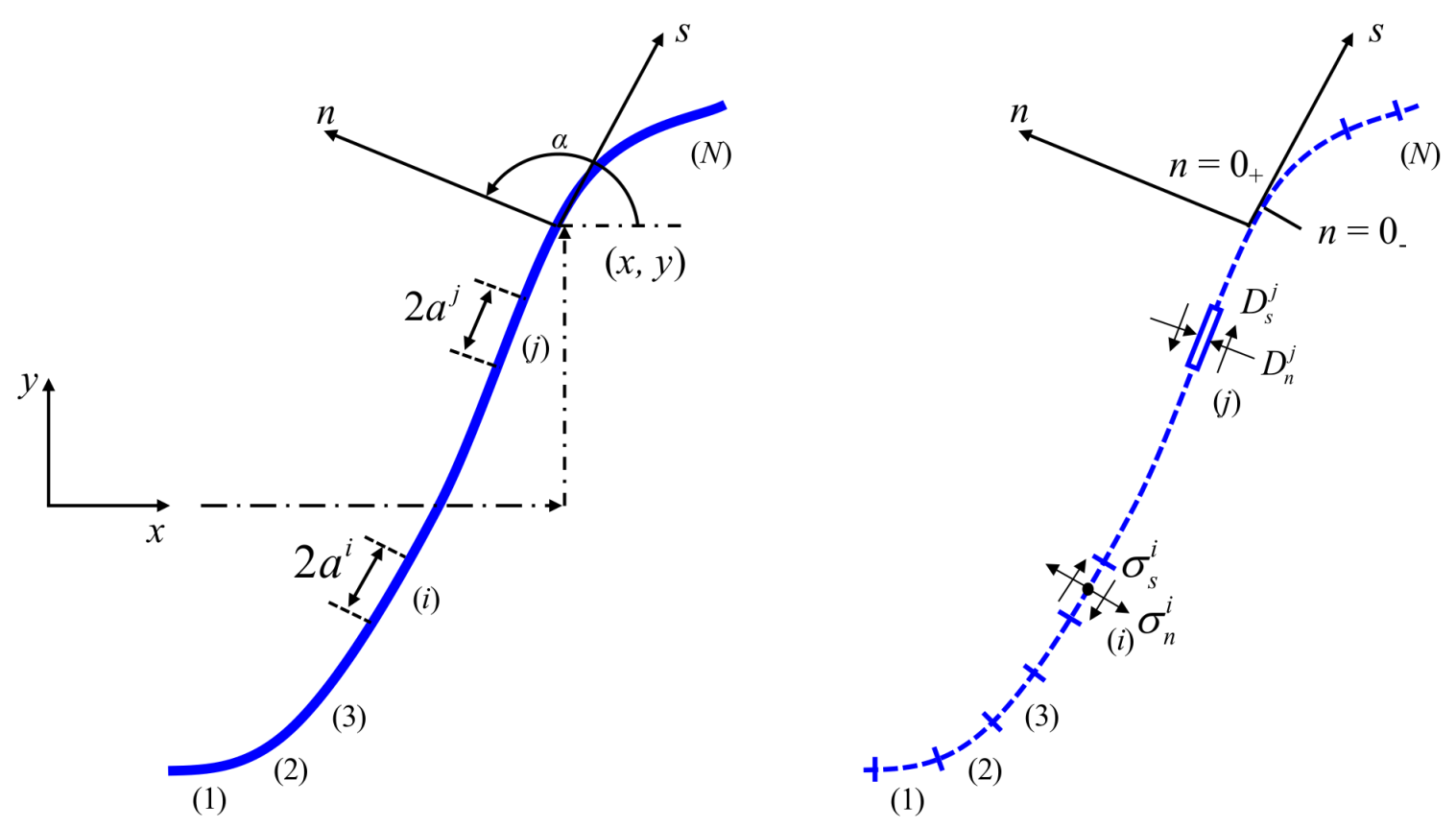

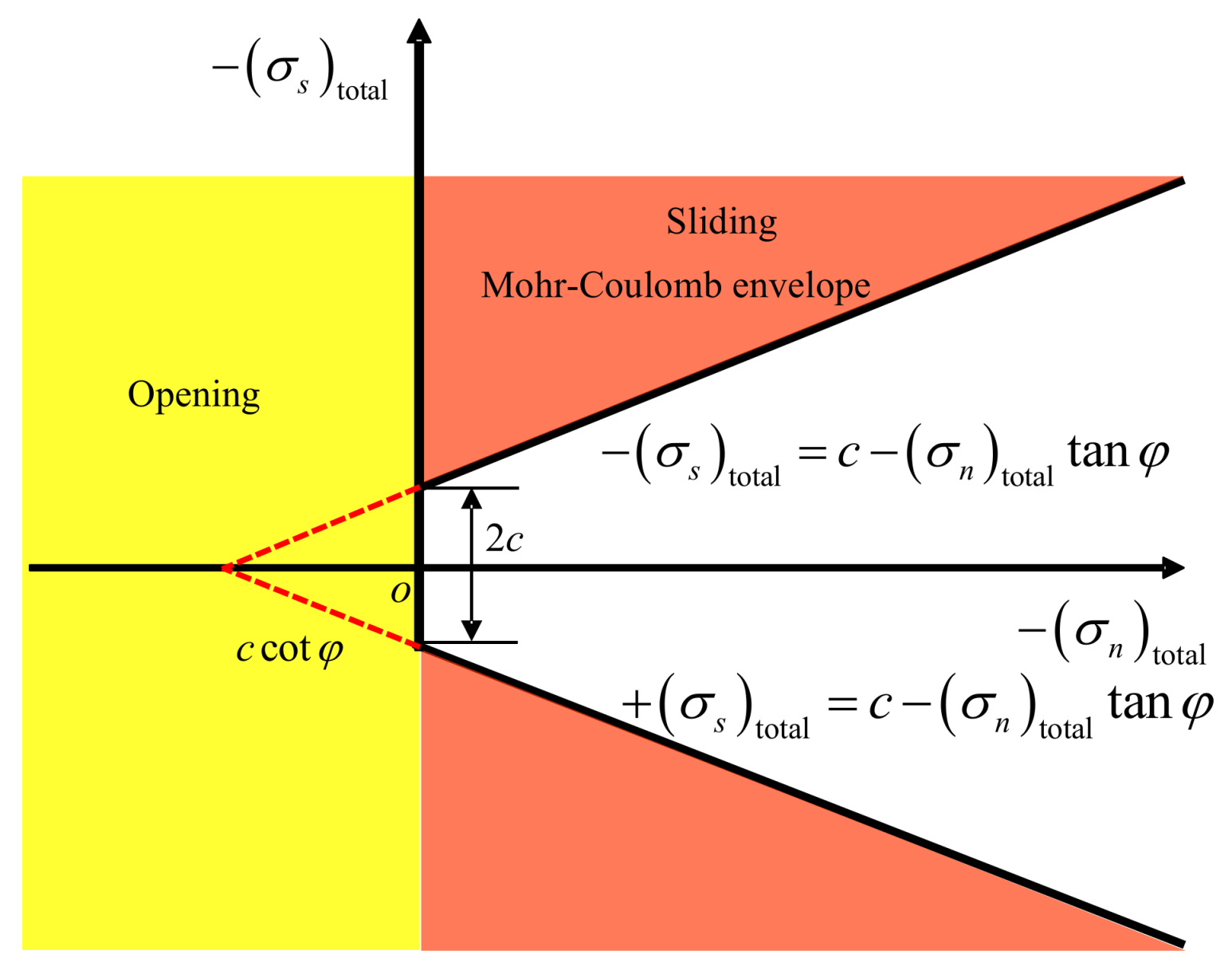


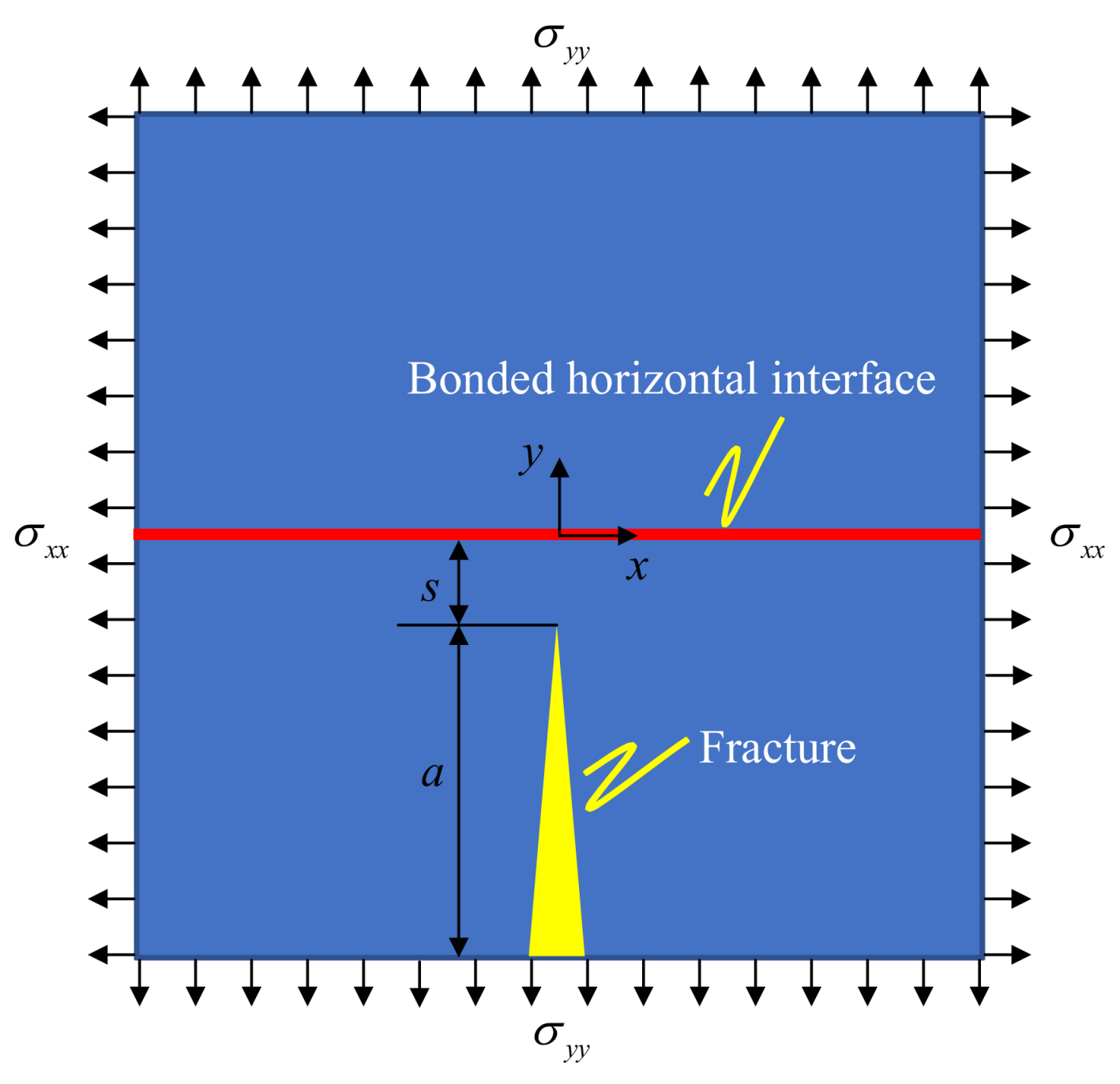
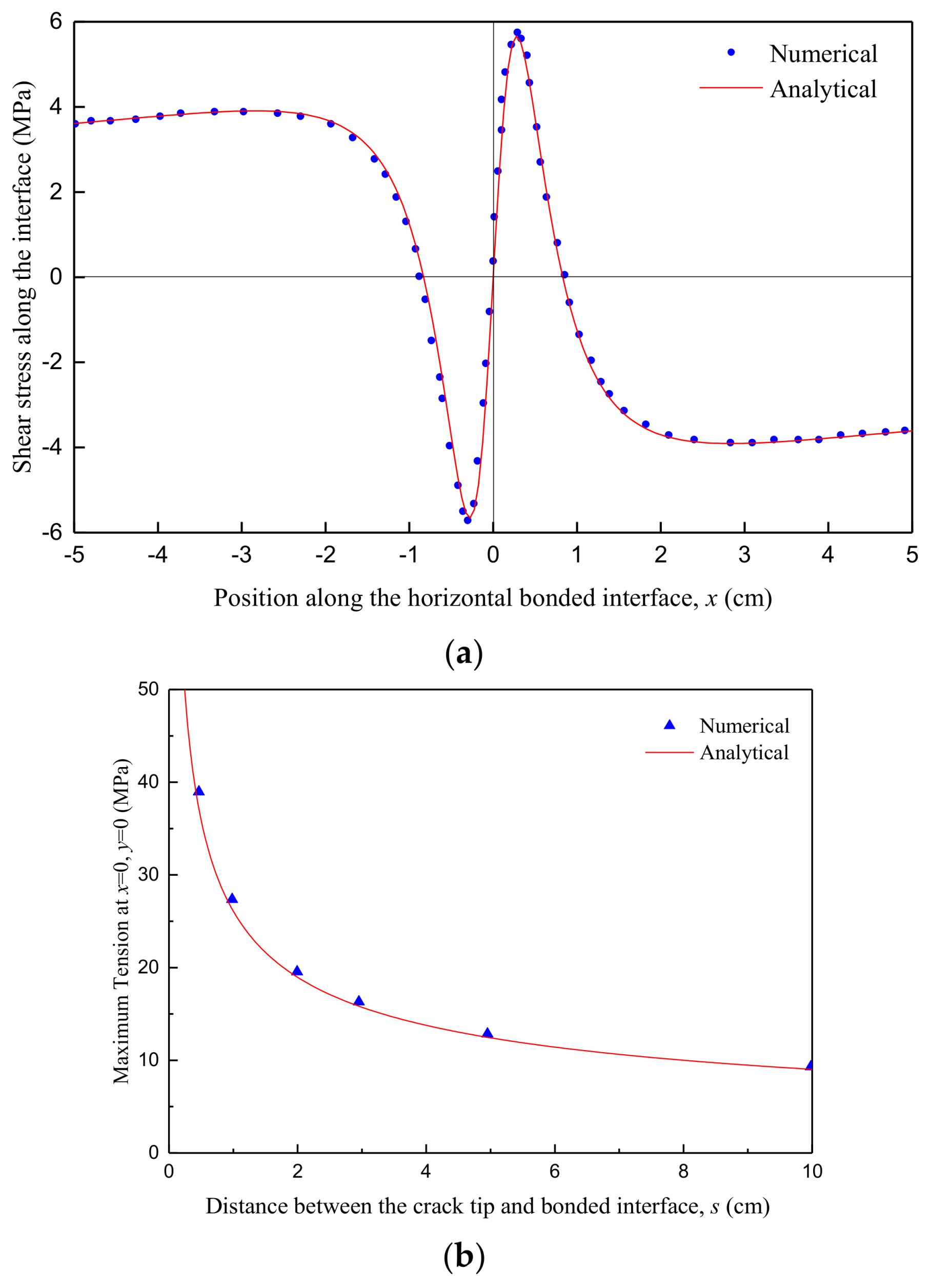
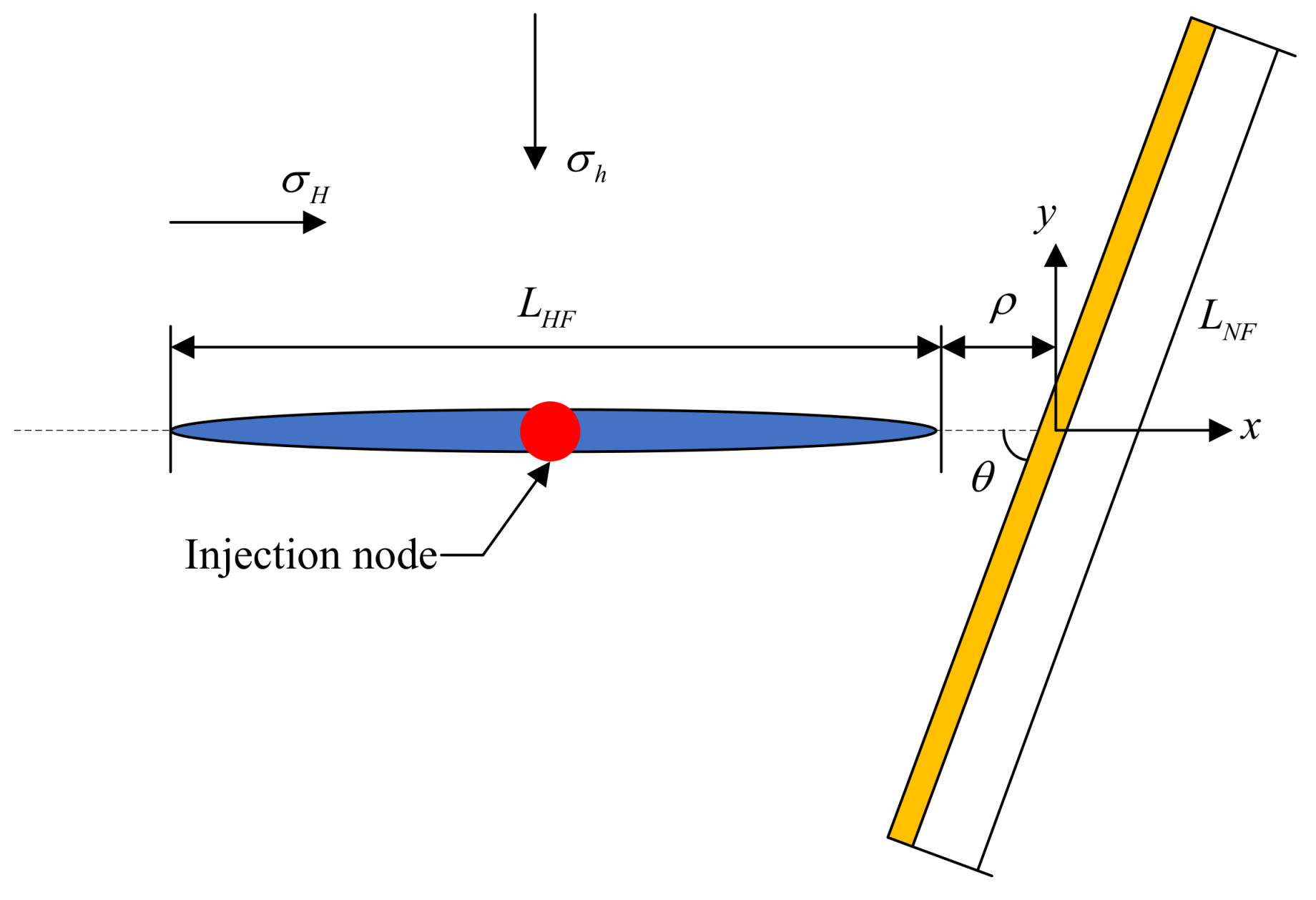

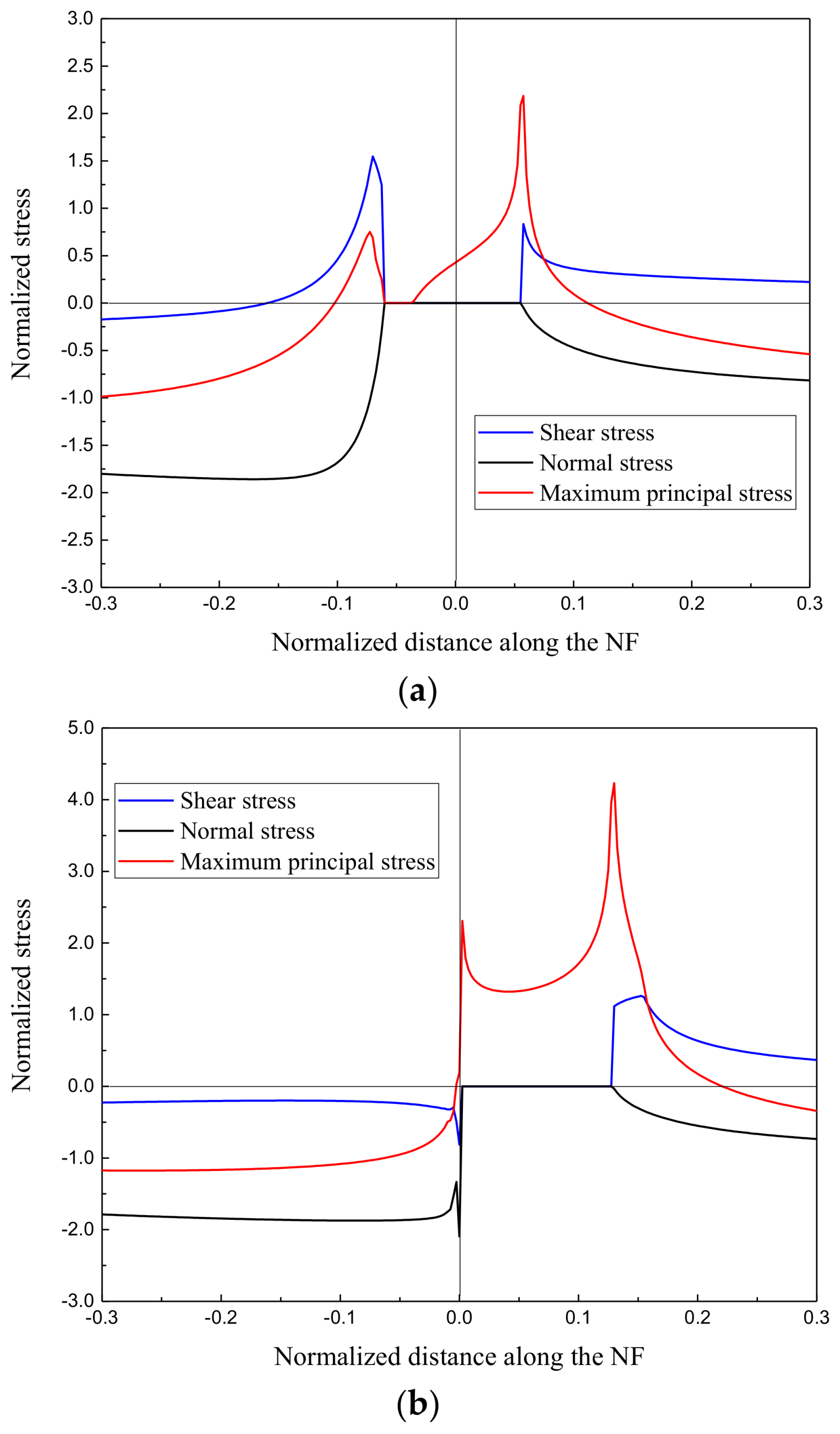
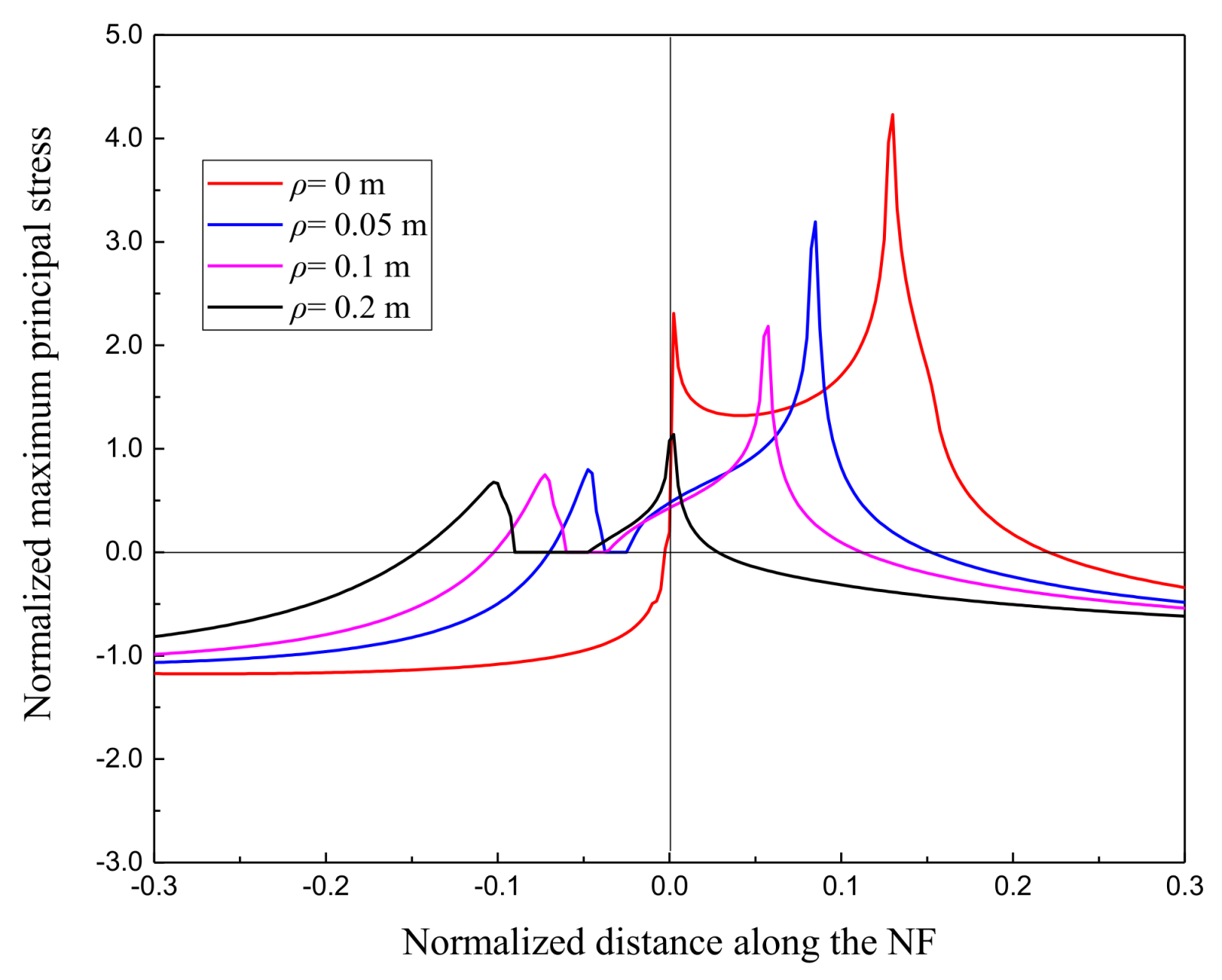
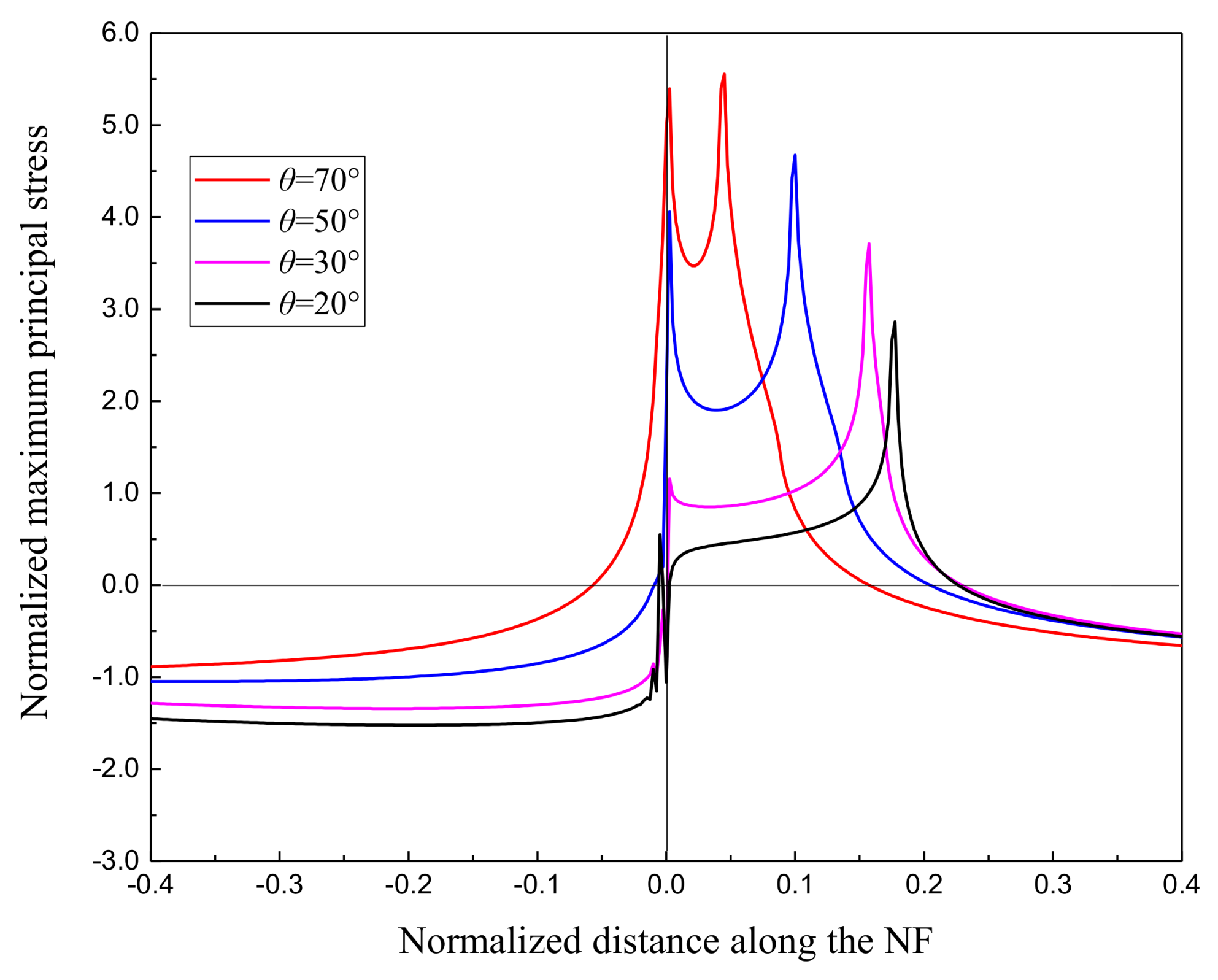

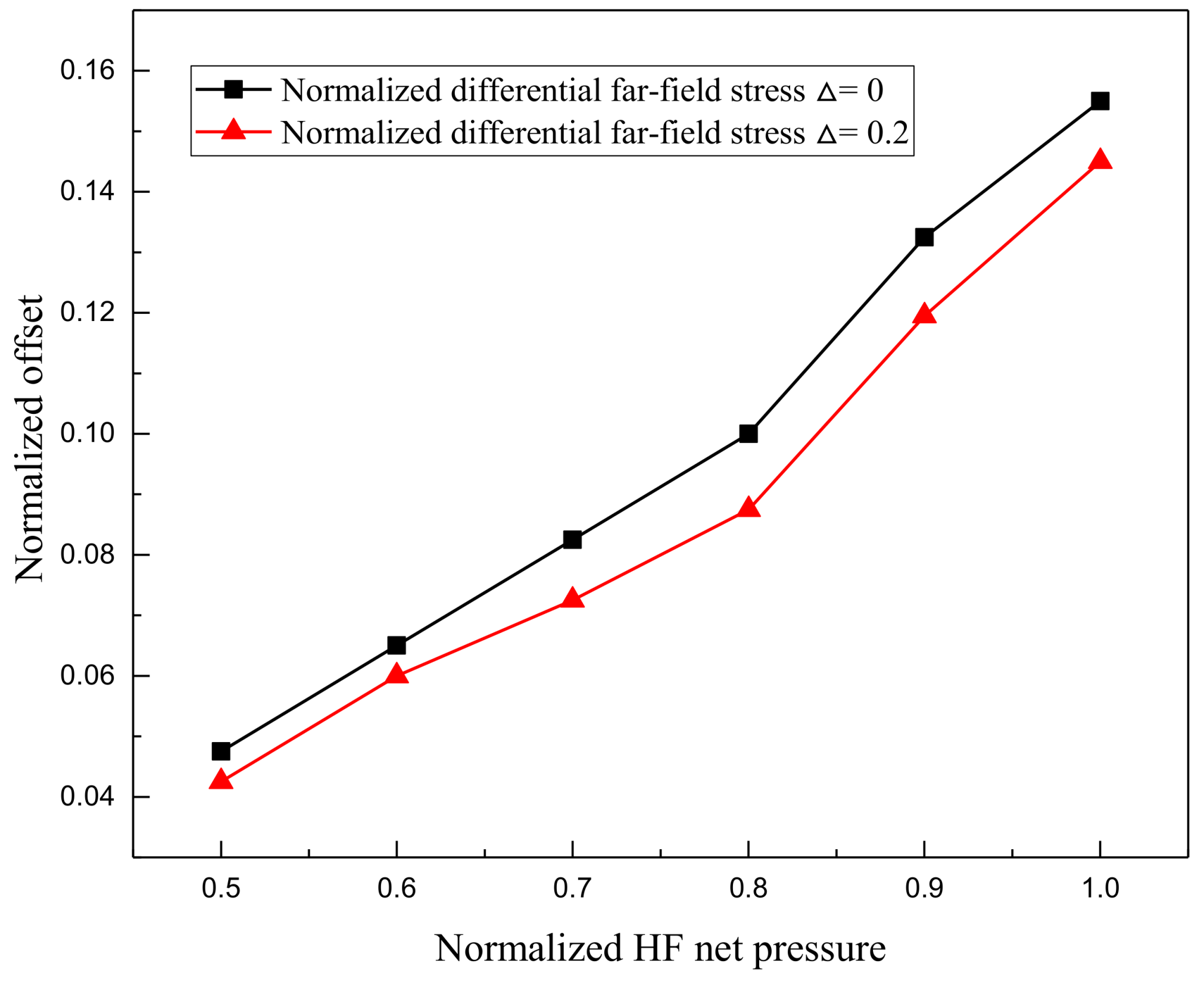


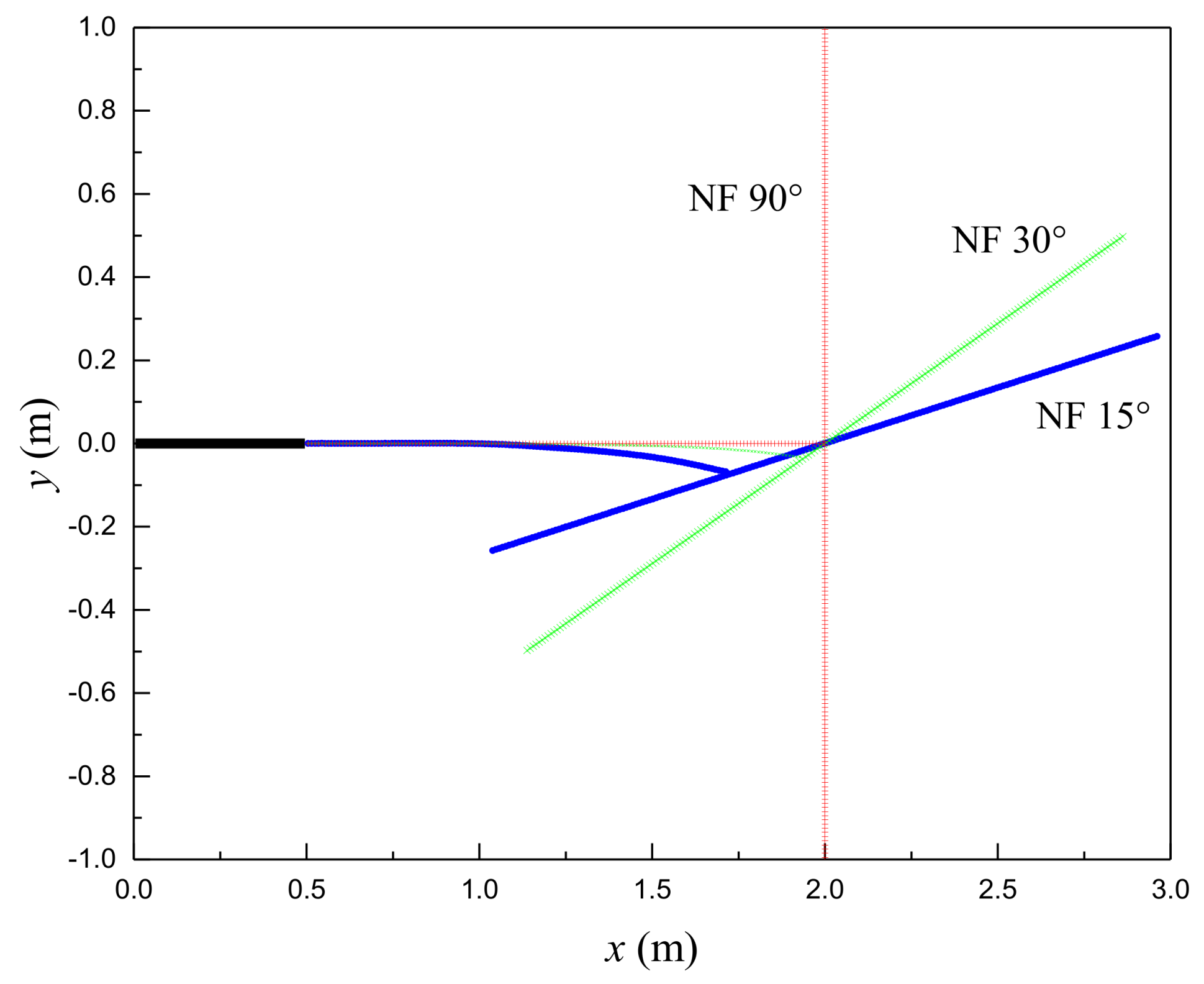

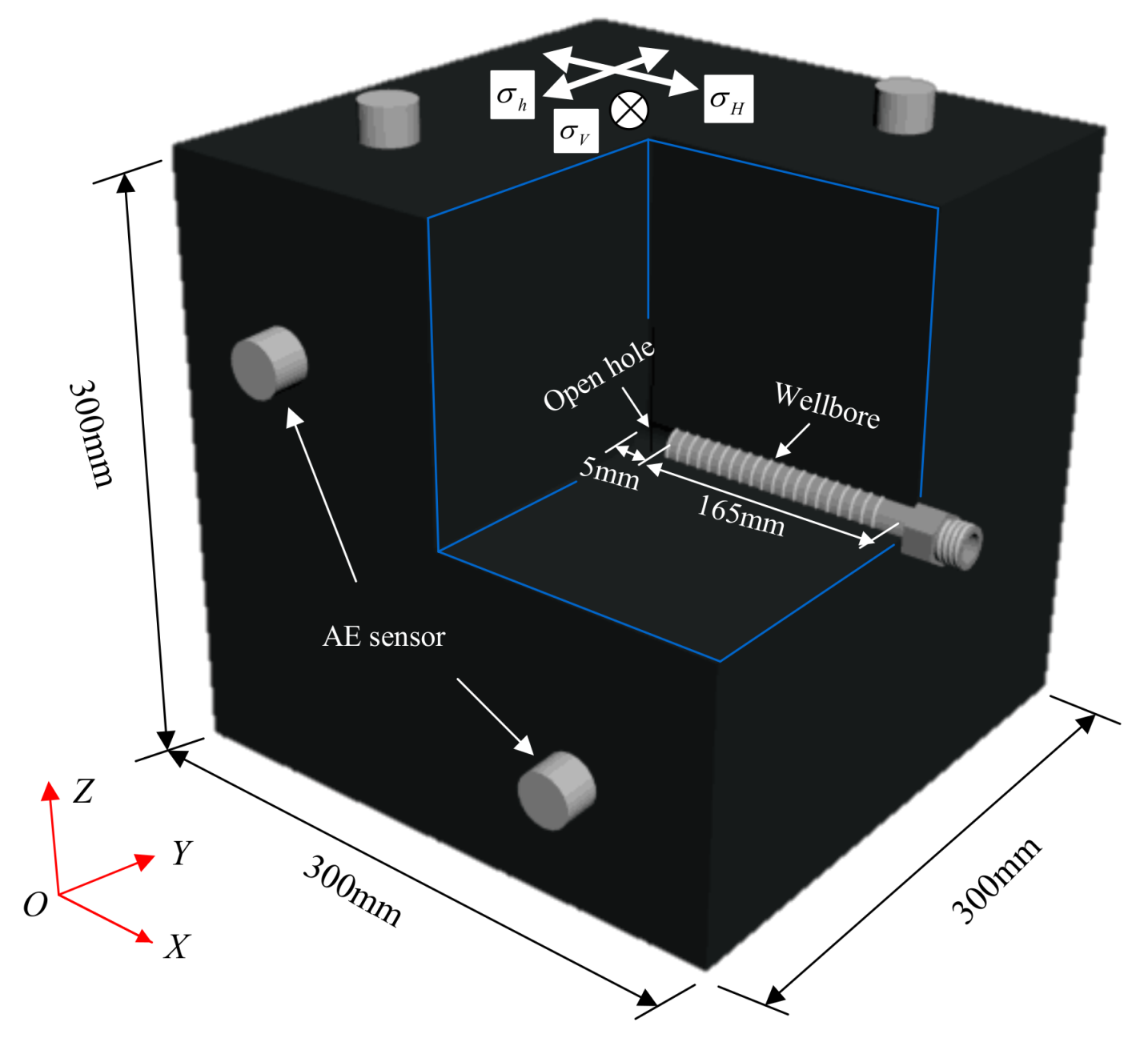
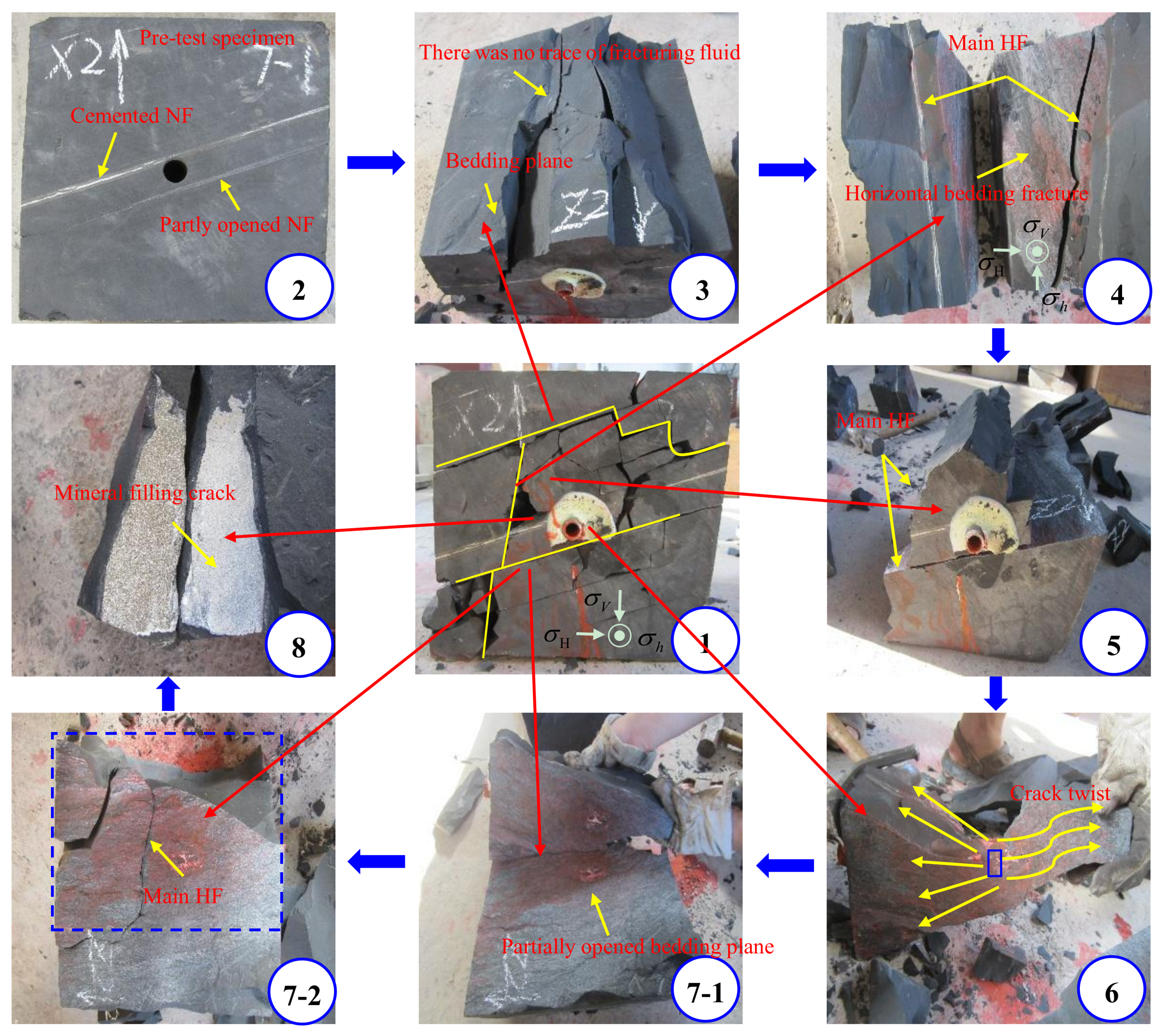
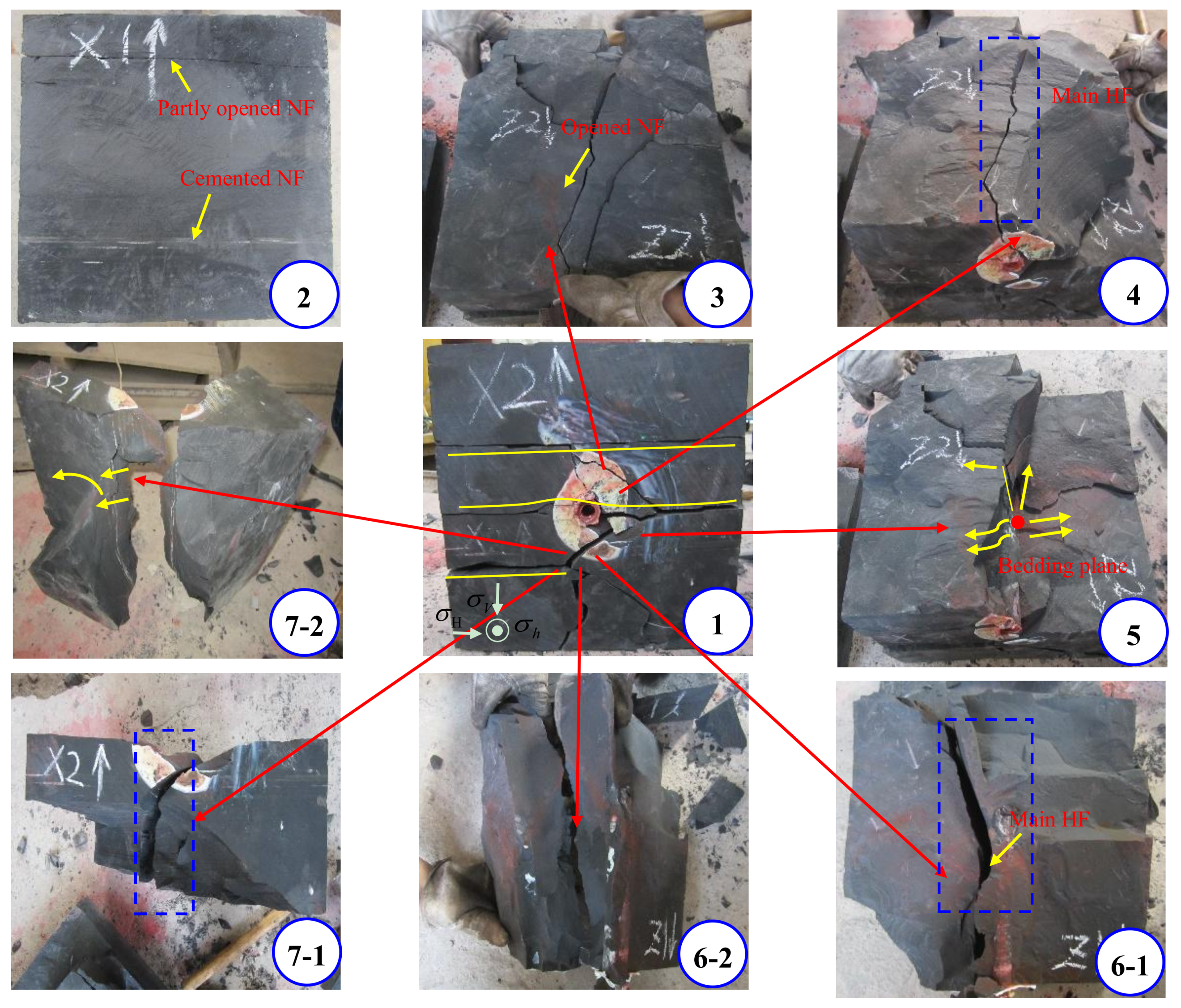
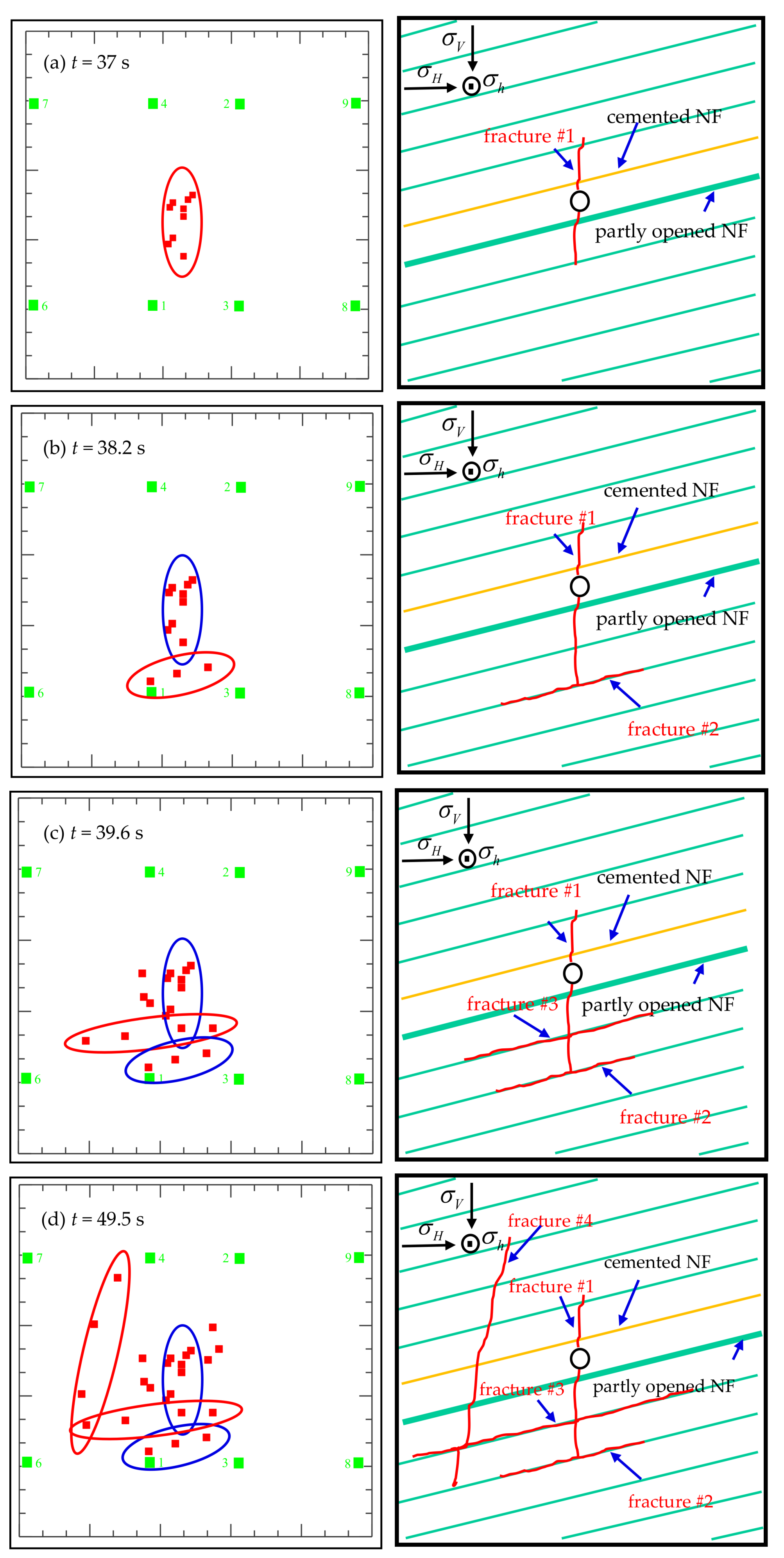
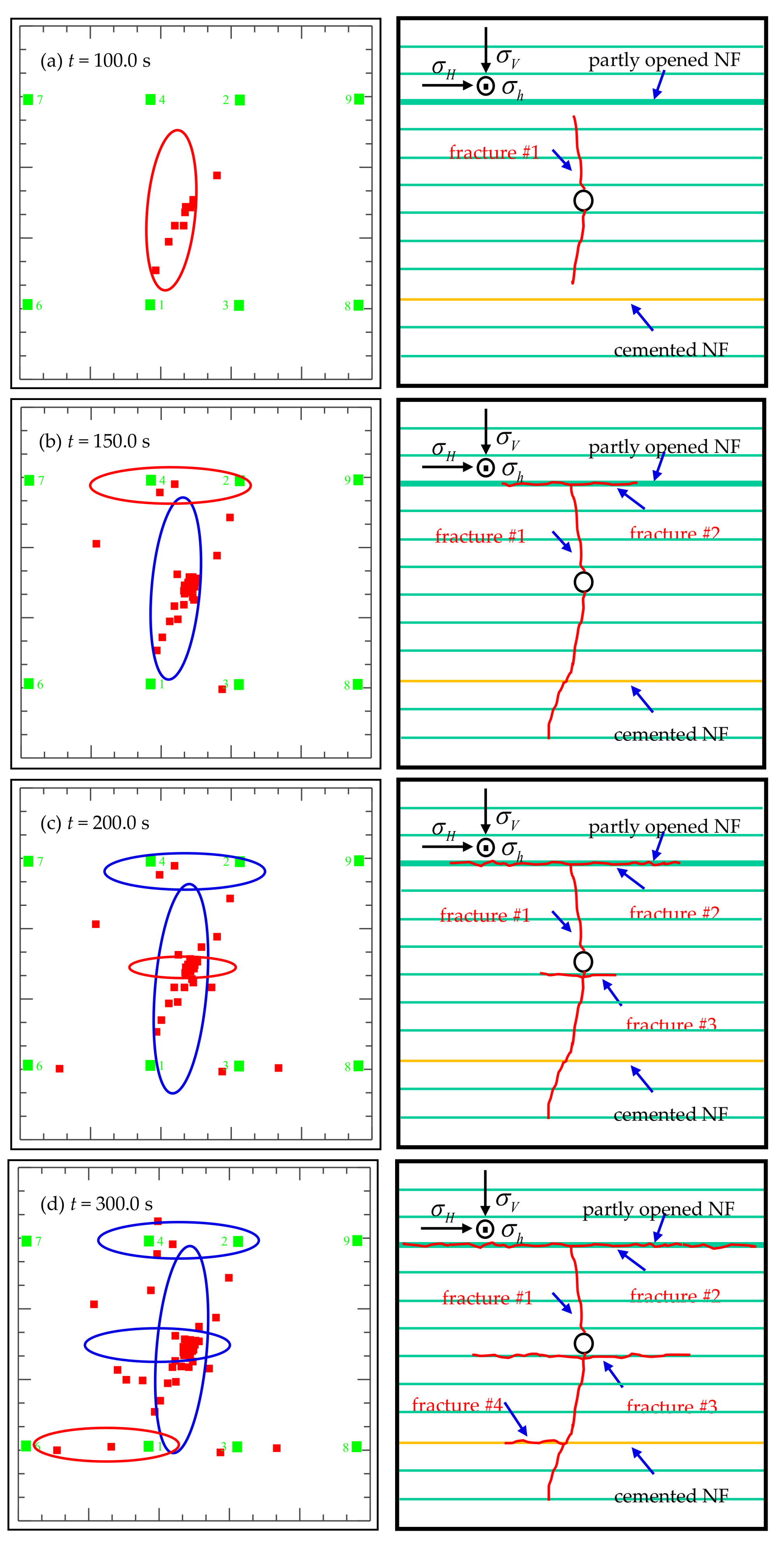
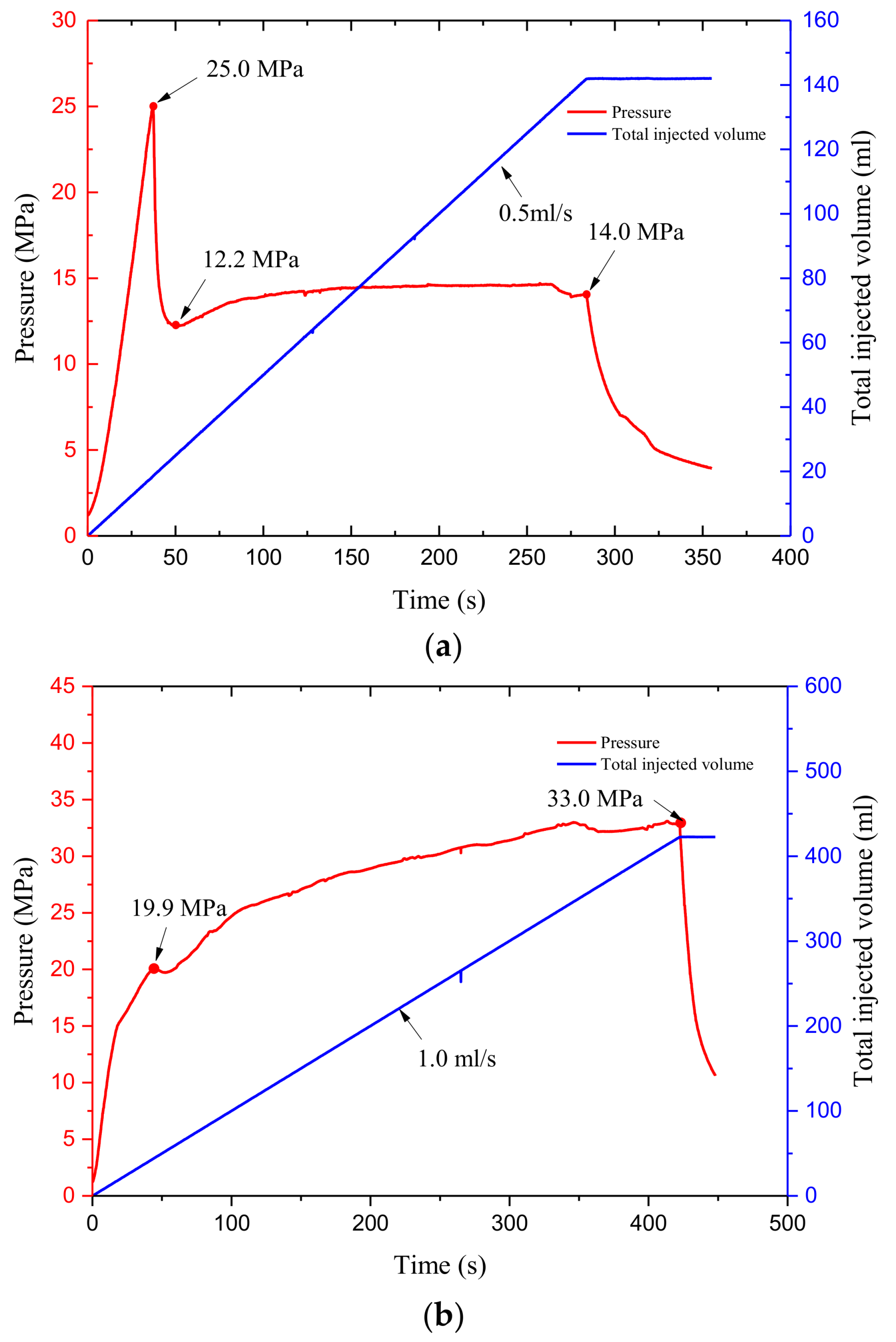
| Parameter | Unit | Value |
|---|---|---|
| Initial length of natural fracture | m | 2.0 |
| Inclination of natural fracture | ° | 40 |
| Cohesion of natural fracture | MPa | 2.2 |
| Friction angle of fracture | ° | 26.6 |
| Normal stiffness of natural fracture | MPa/m | 0.5 × 106 |
| Shear stiffness of natural fracture | MPa/m | 0.25 × 106 |
| Initial Length of hydraulic fracture | m | 2.0 |
| Fluid pressure in the hydraulic fracture | MPa | −3.9 |
| Initial gap between the fractures | m | 0.1 |
| Elasticity modulus | GPa | 14 |
| Poisson’s ratio | - | 0.1 |
| Maximum horizontal stress | MPa | −2.1 |
| Minimum horizontal stress | MPa | −1.9 |
| Specimen Number | Simulated Well Type | Liquid Type | σv (MPa) | σH (MPa) | σh (MPa) | Flow Rate (ML/s) |
|---|---|---|---|---|---|---|
| Y-7-1 | horizontal well | fresh water | 20.00 | 19.51 | 16.98 | 0.5 |
| Y-7-3 | 1.0 |
© 2018 by the authors. Licensee MDPI, Basel, Switzerland. This article is an open access article distributed under the terms and conditions of the Creative Commons Attribution (CC BY) license (http://creativecommons.org/licenses/by/4.0/).
Share and Cite
Chang, X.; Guo, Y.; Zhou, J.; Song, X.; Yang, C. Numerical and Experimental Investigations of the Interactions between Hydraulic and Natural Fractures in Shale Formations. Energies 2018, 11, 2541. https://doi.org/10.3390/en11102541
Chang X, Guo Y, Zhou J, Song X, Yang C. Numerical and Experimental Investigations of the Interactions between Hydraulic and Natural Fractures in Shale Formations. Energies. 2018; 11(10):2541. https://doi.org/10.3390/en11102541
Chicago/Turabian StyleChang, Xin, Yintong Guo, Jun Zhou, Xuehang Song, and Chunhe Yang. 2018. "Numerical and Experimental Investigations of the Interactions between Hydraulic and Natural Fractures in Shale Formations" Energies 11, no. 10: 2541. https://doi.org/10.3390/en11102541
APA StyleChang, X., Guo, Y., Zhou, J., Song, X., & Yang, C. (2018). Numerical and Experimental Investigations of the Interactions between Hydraulic and Natural Fractures in Shale Formations. Energies, 11(10), 2541. https://doi.org/10.3390/en11102541






